May 2022 Newsletter
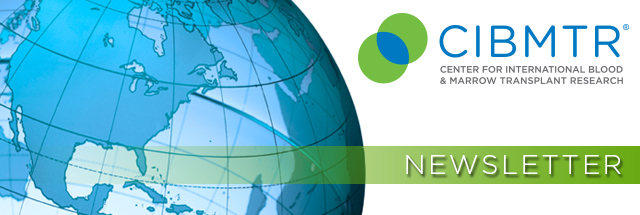
Volume 28, Issue 2
Table of Contents:
-
Perspectives
-
Celebrate 50 Years of the CIBMTR
-
Graft-versus-Host Disease Working Committee
-
Pediatric Cancer Working Committee
-
2022 Tandem Meetings
-
2022 Tandem Meetings: Clinical Research Professionals / Data Management Track
-
2022 Tandem Meetings: Health Services Research Studies Presented
-
CIBMTR Study on Mismatching Inspires Podcast, Tool
-
Data Back to Centers (DBtC) – Updated Data
-
2022 Tandem Meetings: CAR-T Activity, Working Committees, and Sneak Peaks
-
Data Transformation Initiative Continues to Refine the Data Collection Solution
-
Share Your Research
-
Publicly Available Datasets
-
Our Supporters
-
Abbreviations
Perspectives: Social Insecurity
By John Wingard, MD
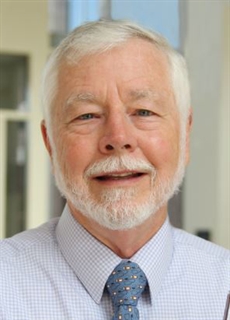 Before …
Before …
I sit before my laptop uncertain. My finger traces over the mouse's scroll wheel. Should I click or not? Maybe I should think about this some more.
For most of my childhood, I was shy. I felt so much more comfortable in my personal space. Social encounters evoked anxiety. In my adulthood, I largely abandoned that habit. But, with the social distancing and wearing masks during the COVID-19 pandemic, coupled with a general sense of apprehension, I reclaimed that quiet corner.
There; it's done. I booked my flight to Salt Lake City (SLC). 2022 Tandem Meetings, here I come!
For weeks I debated. Am I ready? Do I really want to go now? I have not done any professional travel for three years. Am I ready to reenter the live social world? Do I know how to act outside of a Zoom "box"?
I have sat with my patients over the months as I listened to their anguish at not being able to see loved ones. Their fears and uncertainties squared off against their lament over the loss of shared intimacies with families and friends. The simple pleasures of banal chatter with those with whom we feel safe. I confess I have had those same feelings. We would discuss the pros and cons of travel. Simply stated: "Doc, is it safe?" What does one say to that question? Does safe even have any meaning in these times?
Last week my wife and I went over to our next-door neighbors for wine and cheese. Neighbors celebrating the completion of our spring garden resets. A real get-together! It was a first for us and them. The awkwardness we felt before we knocked on their door was quickly replaced by easy banter. We stayed much longer than the hour we had anticipated. Later, we agreed it was so much fun. Certainly, the courage to advance had its rewards.
Do I even know how to travel smartly anymore? I have forgotten all the habits of travel I had learned to shield me from the inconveniences and occasional indignities one faces. Now, those rhythms are to be relearned. Now, I am about to return to the public space once again. How quickly will I relearn old reflexes?
And afterward …
I experienced the trip as a delightful adventure. What a pleasure to be somewhere different! Seeing snow-capped mountains just beyond the cityscape.
I loved the SLC way to cross a street: Grab a red flag from a canister attached to a light post, wave it furiously as you step out into traffic, and trust that cars will magically stop for you. I wonder if that would work in East Coast cities?
I was amused by the collection of street signs in front of the convention center, each with contrasting phrases: "Near and Far, "Lead and Follow," "Exception Rule," and "Flat or Phillips." I think you get the idea. I googled to learn that this art piece is meant to convey a sense of place, a place for discourse, questioning, and learning. A bit of whimsy far removed from my COVID-19 isolation.
The pleasures continued into the building. Did I mention we transplanters shared the space with a convention of bodybuilders who were holding a national weightlifting championship? It was not hard to spot who belonged to which group. The lack of facemasks was not the most obvious way to tell the difference between the two groups. This clash of cultures was at times downright comical. The occasional thunderous booms peeling down the hallway punctured the solemnity of the convention space as lifters threw down their barbells with relish after the lift. No subtlety. Gives new meaning to throwing down the mic. We might learn a thing or two from them about how to finish a talk. No time for Q and A. Was there a hidden meaning behind the coming together of bodybuilders and transplant clinicians? I am still thinking about that.
If spending a few moments observing the bodybuilders amped up the heart rate, there was always the dog petting booth to calm one's tensions. A truly unexpected pleasure. Then, there was a baby kangaroo one could also pet. Yes, Seriously! Who thought of that? Best addition to the Tandem Meetings ever!
Oh, did I mention there were scientific sessions? The sessions were really good! Some whispered that this was the best Tandem Meetings ever! I confess my attention span had deteriorated over the past two years with spending hours on Zoom sessions and often being tempted by digital distractions. It really helped to sit in a darkened room, digital devices turned off, listening attentively to a presentation. I re-found my attention span. Another forgotten habit.
I always have loved walking through the poster sessions. What a pleasure it is to walk up to a fellow standing alone at an unvisited poster and ask him / her to tell me about the work. You can see a face beam with excitement and pleasure.
One other thing: The social insecurity I mentioned earlier? My guard melted with the first warm greeting from a friend not seen in all too long. There seemed to me to be lots of hugs, and hugs lasted longer at this meeting. I loved the meeting. Social graces came back quickly, and there was a newfound appreciation for what, in the past, had become taken for granted.
Celebrate 50 Years of the CIBMTR
2022 marks the CIBMTR's 50th anniversary. Cellular therapy has come a long way from its roots in the Cold War of the 1950s, from an experimental treatment for radiation sickness to standard therapy for leukemia, lymphoma, and sickle cell disease. Now, cellular therapy includes both blood and marrow transplantation and other adoptive cellular therapies.
The story began in 1972 when a handful of doctors from the US, France, and the Netherlands created an international registry of transplants in order to see which therapies helped people the most. Over time, this informal alliance grew to involve many more countries and a formal research collaboration between the Medical College of Wisconsin and the National Marrow Donor Program®/Be The Match®.
Today, the CIBMTR receives data from about 350 medical centers worldwide and has analyzed the clinical outcomes of 600,000 people who underwent blood and marrow transplantation. Recently, the CIBMTR expanded to include data for other cellular therapies, such as chimeric antigen receptor T cell (CAR-T) therapy.
To help recognize this important milestone, the new CIBMTR Apparel Store is now open! Help support the CIBMTR by purchasing a T-shirt or softshell jacket displaying our 50th-anniversary logo.
Graft-versus-Host Disease Working Committee

Members of the CIBMTR Pediatric Working Committee took a selfie during the 2022 Tandem Meetings Reception. From left to right: Joseph Pidala, MD, PhD; Karen Chen, MS; Carrie Kitko, MD; Stephanie Lee, MD, MPH; Margaret MacMillan, MD, MSc; and Stephen Spellman, MBS. Not pictured: Tao Wang, PhD.
Committee Leadership
Co-Chairs:
- Carrie Kitko, MD, Vanderbilt University Medical Center, Nashville, TN
- Margaret MacMillan, MD, MSc, University of Minnesota, Minneapolis, MN
- Joseph Pidala, MD, PhD, H. Lee Moffitt Cancer Center and Research Institute, Tampa, FL
Scientific Directors:
- Stephanie J. Lee, MD, MPH, Fred Hutchinson Cancer Center, Seattle, WA
- Stephen Spellman, MBS, CIBMTR NMDP
Statistical Director:
- Tao Wang, PhD, CIBMTR MCW
Statistician:
- Karen Chen, MS, CIBMTR MCW
GVHD remains a major complication of allogeneic HCT. Ongoing efforts to understand, prevent, and treat both acute and chronic GVHD are of major importance to the transplant community. The GVHD Working Committee is committed to leveraging the robust data resources and statistical expertise of the CIBMTR to address impactful research questions in the field.
As a major update to the committee leadership structure, the GVHD Working Committee announces Stephanie J. Lee, MD, MPH, as a new Scientific Director and shares sincere gratitude for all of Mukta Arora's, MD, contributions previously in this role.
The committee remains very active, with several recent presentations and publications arising from the GVHD Working Committee study portfolio. Some notable recent examples include studies addressing mortality risk in older subjects with chronic GVHD, GVHD characteristics following post-transplant cyclophosphamide-based prophylaxis, and risk for bloodstream infections after acute GVHD.
The committee currently has seven studies in progress that will explore new and exciting research avenues. One study will examine the impact of donor clonal hematopoiesis on HCT outcomes, an issue of increasing significance, especially in older related donors. Other studies will implement new analysis approaches and large data sets, including machine learning in one study, and multi-state modeling in another. These demonstrate the collaborative nature of the GVHD Working Committee to address complex research questions. Importantly, the committee is also studying the impact of racial, ethnic, and socioeconomic health disparities on the outcome of chronic GVHD. Overall, the current study portfolio has great potential to address priority research questions in the field.
The GVHD Working Committee is highly interested in new proposals, and specifically welcomes the involvement of junior investigators. The GVHD Working Committee recently reviewed new proposals during the committee's meeting at the 2022 Tandem Meetings of ASTCT & CIBMTR, and other proposal submissions are welcome throughout the year. We are very open to discussing new concepts and are open to consultation and collaboration on proposal development. We also note that data sets from previously published studies are now publicly available for secondary analyses at this link.
Pediatric Cancer Working Committee
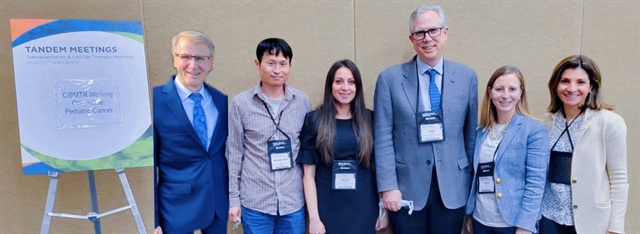
Members of the CIBMTR Pediatric Working Committee pose for a photo after their meeting during the 2022 Tandem Meetings. From left to right: Gregory Yanik, MD; Kwang Woo Ahn, PhD; Rasha Atshan, MS; Kirk Schultz, MD; Larisa Broglie, MD, MS; and Muna Qayed, MD, MSc.
Committee Leadership
Co-Chairs:
- Gregory Yanik, MD, The University of Michigan, Ann Arbor, MI
- Muna Qayed, MD, MSc, Children's Healthcare of Atlanta at Egleston, Atlanta, GA
- Kirk Schultz, MD, The University of British Columbia, Vancouver, BC, Canada
Scientific Director:
- Larisa Broglie, MD, MS, Children's Hospital of WI, CIBMTR MCW, Milwaukee, WI
Statistical Director:
- Kwang Woo Ahn, PhD, CIBMTR MCW
Statistician:
- Rasha Atshan, MS, CIBMTR MCW
The Pediatric Cancer Working Committee provides scientific oversight for studies related to allogeneic and autologous HCT for children, adolescents, and young adults with cancer. As transplantation approaches differ from adults, independent evaluation of pediatric patients is necessary to help advance transplant outcomes for this population.
This past year the Pediatric Cancer Working Committee underwent a transition in leadership; Larisa Broglie, MD, MS, assumed the role of Scientific Director of the Working Committee in July 2021. Our chairs have taken an active role in the mentorship of junior investigators, helping to bring to completion an important study by Tristan Knight, MD, evaluating the impact of cell dose on outcomes during autologous transplantation for neuroblastoma and central nervous system tumors. The results were presented at the 2022 Tandem Meetings of ASTCT & CIBMTR, and manuscripts are being prepared for submission. Additionally, efforts to improve collaboration with our European colleagues from EBMT and with other collaborative groups are underway. To enhance the power of our analysis, the datasets from EBMT and CIBMTR databases will be merged to uncover the impact of pre-transplant extramedullary disease on the outcome of allogeneic HCT for AML in children. The study is led by Deepak Chellapandian, MD, MBBS, and Hemalatha Rangarajan, MD, from the CIBMTR, and Selim Corbacioglu, MD, from EBMT. A third study led by Susan Prockop, MD, is currently in the protocol development stage and will evaluate the effect of T-cell chimerism on relapse. Lastly, a final study is ongoing using biological samples from the CIBMTR / NMDP repository to identify germline mutations that contribute to the development of myelodysplastic syndromes in children.
The success of our committee depends on new ideas and testable hypotheses as well as the participation of individuals with different perspectives and scientific backgrounds. Having an engaged group of investigators is what allows us to conduct impactful studies. The Pediatric Cancer Working Committee encourages all investigators with an interest in pediatric cancer to propose studies, which may be submitted on the "How to Propose a Study" webpage. Datasets of prior studies are publicly available for download and analysis by independent researchers. We encourage colleagues with an interest in research with the CIBMTR and Pediatric Cancer Working Committee to reach out to the leaders of this committee to discuss ideas and collaboration through either of these avenues. Working Committee chairs are available to discuss your study's hypothesis and feasibility prior to submission to the CIBMTR.
2022 Tandem Meetings I Transplantation & Cellular Therapy Meetings of ASTCT™ and CIBMTR®
By Tia Houseman
Tandem Meetings | Transplantation & Cellular Therapy Meetings of ASTCT™ and CIBMTR® (Tandem Meetings) are the combined annual meetings of the American Society for Transplantation and Cellular Therapy (ASTCT) and the Center for International Blood & Marrow Transplant Research (CIBMTR). Administrators, clinicians, data manager / clinical research professionals, fellows-in-training, investigators, laboratory technicians, MD/PhDs, nurses, nurse practitioners, pharmacists, physician assistants, and other allied health professional attendees benefit from a full scientific program that addresses the most timely issues in HCT and cellular therapy.
After two years from the last in-person Tandem Meetings and having to postpone from February 2022 to April 2022 due to the Omicron variant, we were able to join again for the 2022 Tandem Meetings of ASTCT and CIBMTR in Salt Lake City, Utah, April 23-26. This year more than 4,400 registered attendees from 51 countries participated in the 2022 Tandem Meetings with more than 2,500 joining us in person and more than 1,900 virtually. All registrants of the 2022 Tandem Meetings have access to view the session recordings post-event.
2022 marked the 50th Anniversary of the CIBMTR which was highlighted in the plenary session, 50th Anniversary of the CIBMTR: Building on the Past to Address the Challenges of the Future.
Program Co-Chairs Margaret MacMillan, MD, MSc, FRCPC, and Katherina Fleischhauer, MD, along with the Scientific Organizing Committee, put together an excellent program consisting of 6 plenary sessions and 9 concurrent sessions. The meeting also included:
- 6 breakfast symposia and 5 luncheon symposia,
- 13 oral abstract sessions with 90 abstracts presented,
- 15 product and innovation theaters, more than 300 posters with a Meet-The-Authors Reception,
- 15 CIBMTR Working Committee meetings and a CIBMTR Collaborative Working Committee Study Proposal Session,
- 14 ASTCT Spotlight Sessions (including 2 fully virtual sessions pre-meeting),
- 11 Meet-the-Professor sessions (including 4 fully virtual pre-meeting).
- In addition to an outstanding scientific program, sessions targeted toward specific fields "tracks" were held for administrative directors, advanced practice providers, pediatrics, BMT CTN coordinators, clinical research professionals / data managers, information technologists and informatics, nurses, and pharmacists.
Awards
2022 CIBMTR Distinguished Service Award: Adriana Seber, MD
The CIBMTR collaborates with the global scientific community to advance HCT and cellular therapy research worldwide. The purpose of the Distinguished Service Award is to recognize individuals who have made outstanding contributions to the CIBMTR's research mission in one or more of the following areas: promoting HCT research and clinical care in developing countries, advancing the field despite unique challenges; expanding the availability of transplantation, disseminating research results to clinicians and patients to improve outcomes and quality of life, and collaboration with organizations to increase data exchange and research collaboration worldwide.
2022 ASTCT Lifetime Achievement Award: Effie W. Petersdorf, MD
The ASTCT Lifetime Achievement Award recognizes an individual who has made continuing contributions to the field of blood and marrow transplantation, either in basic biology or clinical application.
ASTCT Public Service Award: Damiano Rondelli, MD
The ASTCT Public Service Award recognizes an individual who has advanced the interests of the BMT and cellular therapy field or has given special service to the patients and families served.
Lectures
Mortimer M. Bortin Lecture: Stephanie J. Lee, MD, MPH: Progress in Chronic Graft-Versus-Host Disease Over the Past 2 Decades: It Took a Village
The Mortimer M. Bortin Lecture commemorates the Founding Scientific Director of the International Bone Marrow Transplant Registry (IBMTR, forerunner of the CIBMTR), whose foresight and dedication were critical to the development of the CIBMTR as a global resource of HCT research. Lecturers are chosen on the basis of their contributions to our understanding of graft-versus-tumor effects and/or the advancement of clinical HCT Research.
E. Donnall Thomas Lecture: Marcel R.M. van den Brink, MD, PhD: Improving Cancer Immunotherapy: Follow Your Gut!
In honor of Dr. Thomas, the E. Donnall Thomas Lecture recognizes an eminent physician or scientist, either a clinician or investigator, who has contributed meritoriously to the advancement of knowledge in blood and marrow transplantation.
Networking
There were several networking opportunities offered during the 2022 Tandem Meetings, including the 2022 Tandem Meetings Networking Reception in the Exhibit Hall, 2022 Tandem Meetings Poster Reception: Meet the Authors, Tandem Meetings Reception Monday evening, and more.
Thank you!
On behalf of the Tandem Meetings of ASTCT & CIBMTR Planning Team, we wish to thank you for all your time, hard work, and dedication to the field, especially during the COVID-19 pandemic. We also appreciate your patience, understanding, and flexibility as we navigated the postponement from February to April this year.
We look forward to seeing you at the World Center Marriott in Orlando, Florida, February 15-19, 2023.
Watch for details on the 2023 Tandem Meetings | Transplantation & Cellular Therapy Meetings of ASTCT and CIBMTR in the coming months. Contact TandemMeetings@mcw.edu for information regarding support opportunities for next year's meeting.
Join the conversation: #Tandem23
2022 Tandem Meetings: Clinical Research Professionals / Data Management Track
By Jillian Kissinger
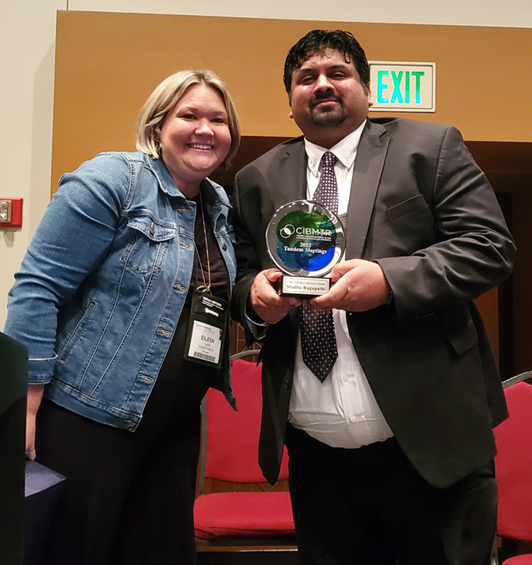
Best Oral Abstract recipient, Madhu Ragupathi, MD, poses for a photo with Eileen Tuschl, DNP, RN, ACNS-BC, APNP, Acting Director of Data Operations, CIBMTR MCW.
We were overjoyed to return in person for our Clinical Research Professionals / Data Management Track at the 2022 Tandem Meetings I Transplantation & Cellular Therapy Meetings of ASTCT and CIBMTR in Salt Lake City, UT. Our hybrid track took place on April 24-25 and was viewed by hundreds of data professionals both in-person and online each day.
Speaker highlights included form spotlight on infection and immune reconstitution, organ toxicity, new transplant drugs in 2021, lymphoma, AML, Center Specific Survival Analysis, cellular therapy updates, gene therapy, forms revision updates, Center Support best practices, audit updates, Data Transformation Initiative, CPI updates, and a pediatrics breakout session on ALL. Additionally, we included a new session that featured best practices from three centers: Cleveland Clinic Foundation, Dana-Farber Cancer Institute / Boston Children's Cancer and Blood Disorders Center, and Baylor University Medical Center. Data managers from these centers presented various best practices, including training and onboarding, CPI, and tools and trackers for increased communication and efficiency.
Madhu Ragupathi, MD, from Baylor University Medical Center, received this year's award for best oral abstract for his presentation titled, "Establishing a routine daily data field review to prepare for a CIBMTR audit."
Additional oral abstracts included:
- "Reaching contemporaneous CIBMTR reporting through goal setting"– presented by Sarah Hatley, RN, from Sarah Cannon Transplant & Cellular Therapy Program at St. David's South Austin Medical Center
- "Improving productivity and monitoring: Utilization of dashboard technology for continuous process improvement forms" – presented by Nicolette M. Minas, MS, CCRP, and Kathleen Ruehle, RN, BMT-CN, from the University of Maryland Medical Center
Presentations from the 2022 Clinical Research Professionals / Data Management Track are available on the CIBMTR Portal > Training & eLearning Tile > Tandem Meetings CRP/ DM Track.
Due to the postponement of the 2022 Tandem Meetings, our New Data Manager Onboarding training was held virtually in February. We look forward to offering in-person New Data Manager Onboarding again next year at the 2023 Tandem Meetings in Orlando, FL. Our next class in 2022 will take place virtually on August 2, 4, 9, and 11 from 12:00 PM - 3:30 PM CDT each day. Registration will open in June and is limited to 35 participants.
Special thanks to all who completed their evaluations! We use these data to improve our meetings and make them as meaningful and impactful as possible.
2022 Tandem Meetings: Health Services Research Studies Presented
By Jaime Preussler, MS
The health services research team draws on a multitude of research methods, including, but not limited to, retrospective and prospective research, administrative claims data analysis, survey design and administration, qualitative methods, data management, and dataset linkage. The team is currently conducting a qualitative study that involves interviews and focus groups to learn more about caregiver requirements and the participants' perspectives on those requirements.
Caregivers provide practical and emotional support for patients. Some transplant centers may require a caregiver and have specific requirements around that role for a patient to receive a transplant; however, it can be difficult for patients who do not have someone that can meet the requirements of serving as a caregiver. Limited studies currently exist that discuss caregiver requirements and perspectives about those requirements. The new study aims to learn from patients, caregivers, and healthcare providers (physicians / advanced practice providers, social workers) about:
- Transplant center caregiver requirements for patients who receive allogeneic HCT
- How caregiver requirements are determined and followed at transplant centers
- Perspectives on those requirements
- Caregiver availability experiences in the first 100 days post-allogeneic HCT
Findings from this study will help develop future programs and interventions to help support patients, caregivers, and transplant centers.
For more information about this study, please email caregiverstudy@nmdp.org.
To learn more about the Health Services Research Program, visit the Health Services Research webpage or email Jen Coles.
CIBMTR Study on Mismatching Inspires Podcast, Tool
A CIBMTR immunobiology research paper on HLA mismatching and risk prediction has already inspired both a podcast and a new bioinformatics research online tool.
The CIBMTR study referenced is an Immunobiology Working Committee study, IB19-02, and the podcast coincides with the publication of "HLA informs risk predictions after haploidentical stem cell transplantation with posttransplantation cyclophosphamide" by Ephraim Fuchs, MD; Shannon McCurdy, MD; Effie Petersdorf, MD; and colleagues, in Blood on March 10, 2022.
On March 10, the American Society of Hematology featured this study in an episode of its Blood Podcast, titled, "COVID-19 vaccination in patients with blood cancers and recalibrating the HLA barrier in haploidentical stem cell transplantation," available online and on iTunes, Spotify, Google Play. This 19-minute episode reviewed 3 recent publications, including the CIBMTR paper. The narrator stated," Fuchs, McCurdy, and coauthors analyzed more than 1,400 haploidentical transplants to determine that it's not the number of matched alleles, but rather the specific location of the HLA mismatch that informs clinical outcomes."
This study identified:
- DRB1 mismatch and B-Leader match contribute additive improvements to overall survival
- DPB1 mismatch improves overall survival
- DRB1 mismatch decreases relapse
- For DRB1 and DQB1, best outcomes were found when matched at DQB1 and mismatched at DRB1, followed by mismatches at both loci
Using data from the study, the CIBMTR's Bioinformatics Research team developed a new tool, "Predictor for probability of disease-free survival after haploidentical transplant." Stephanie Fingerson developed the tool with support from Pradeep Bashyal, and the tool can be freely accessed at: http://haplodonorselector.b12x.org/v1.0/. This tool allows entry of key patient and donor information identified in this study for situations in which patients have potential haploidentical donors and in the context of transplants planning to use post-transplant cyclophosphamide for GVHD prophylaxis treatment. The output sorts donor potential by retrospective data on the patient's highest to lowest disease-free survival probability according to the results of this IB19-02 study. These results can support decision-making in comparable situations for optimal donor selection in the physician's assessment of potential best patient outcomes.
Data Back to Centers (DBtC) – Updated Data
DBtC is an interactive, visual dashboard depicting your center's transplant and cellular therapy data in dynamic charts and graphs. Not only can you visualize and interact with your data on this platform, but the data can also be downloaded via an Excel spreadsheet to work with on your desktop. The data in this application focuses on the top 10% of the most important TED, TED-Equivalent (CRF), and CT TED enrollment, follow-up, Risk Evaluation and Mitigation Strategies (REMS), and survival data points. A more complete list of variables is available in the DBtC-Download application (see note below).
The CIBMTR is proud to announce the DBtC tool found on the CIBMTR Portal has been updated to include data through April 3, 2022. The application is updated monthly, just as in the past. Click here to explore your data.
Note: The DBtC-Download application with bulk data extracts will be updated to reflect up-to-date data as well in the next few weeks.
2022 Tandem Meetings: CAR-T Activity, Working Committees, and Sneak Peaks
By Carlos Litovich, MPH
As we wrap up a great 2022 Tandem Meetings of ASTCT & CIBMTR, we would like to remind everyone once again that session recordings are available via the online agenda or 2022 Tandem Meetings Mobile App for all registered attendees. As expected, we saw an increase in activity and interest in CAR-T topics throughout the four-day event. We invite you to review great talks, including the 50th Anniversary of the CIBMTR: Building on the Past to Address Challenges of the Future plenary session, Oral Abstracts in CAR-T session, the CAR-T and Beyond plenary session, Disparities in Cellular Therapy session, and many more great recordings available to all registered in-person and virtual 2022 Tandem Meetings attendees.
The Cellular Immunotherapy for Cancer Working Committee meeting was held on Sunday, April 24, with eight proposals selected for presentation among more than 100 received. In addition, this year we are excited to welcome the new upcoming Chair Sairah Ahmed, MD, from the MD Anderson Cancer Center. We also welcomed new Cellular Immunotherapy for Cancer Assistant Scientific Director, Amy Moskop, MD, MS, and thanked our esteemed chair, Sarah Nikiforow, MD, who finished her term as co-chair of the Working Committee. Thank you, Dr. Nikiforow for all your work and contributions!
In addition, a new CIBMTR Collaborative Working Committee Session was held on Monday, April 25, to discuss study proposals that span across multiple Working Committees. This session included 8 presentations, including topics on CAR-T cell therapy. This new format for Working Committee study proposal discussion included topics that could be addressed by several committees and offered an opportunity to showcase the breadth of projects proposed to the CIBMTR.
As a sneak peek at upcoming announcements, be on the lookout for a few items! We've begun planning for the joint 2022 AcCELLerate Forum to be scheduled for fall, and we are releasing the 2021 Cellular Therapy Summary Slides soon. More information to come.
Data Transformation Initiative Continues to Refine the Data Collection Solution
By Kristina Bloomquist
In 2022, the Data Transformation Initiative (DTI) began its third program year.
To date, the DTI team has designed, tested, and continues to refine a customized solution that will collect and move data from transplant centers' source data systems directly to the CIBMTR. In parallel, several domestic, US transplant centers have been experimenting with the use of the tool along the way. This has informed refinements to the solution and prepared the way to expand its capabilities to collect and transfer more data variables.
In addition, the team is exploring how to make FormsNet "smarter," with navigation and derivation logic applied to a User Interface. More information on this experiment will be available in October after the solution is tested, and upon the conclusion of several user feedback groups.
DTI's team was also recently in attendance, presenting at April's 2022 Tandem Meetings in Salt Lake City, UT, during the Clinical Research Professionals / Data Managers Track and during the IT Forum. At the IT Forum, a session was devoted to a panel of pilot transplant center leads, who shared their experiences using the tool during the pilot program
The CIBMTR is encouraged by the progress it has made in DTI to date. Technology is proving to be applicable to the tasks associated with both locating and collecting select data in source data systems within transplant centers and with moving these data electronically. In addition, centers that have been engaged in the pilot report high levels of satisfaction via survey responses. Ultimately, this signals to the CIBMTR that DTI is on track to achieve its vision, to "Optimize the acquisition and utilization of the CIBMTR's entrusted data assets to accelerate breakthroughs that transform patient experiences.
Share Your Research
By Jennifer Motl
These new plain-language summaries of CIBMTR research may help your patients:
 |
After BMT, children may delay returning to school Children can return to school after being vaccinated for COVID-19 Read more: accessible or 1-page version
|
 |
BMT may affect hormones and sexual health Check-ups and treatments helpful after allogeneic blood or marrow transplant Read more: accessible or 1-page version
|
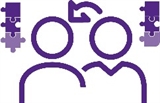 |
Half-matched BMT better than cord blood in some cases Fully matched donors are still the first choice for blood and marrow transplant Read more: accessible or 1-page version
|
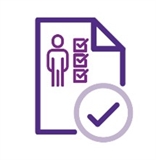 |
Current therapies prevent chronic GVHD equally well Better options are needed to prevent graft-versus-host disease Read more: accessible or 1-page version
|
Find more summaries on the Study Summaries for Patients webpage.
Publicly Available Datasets
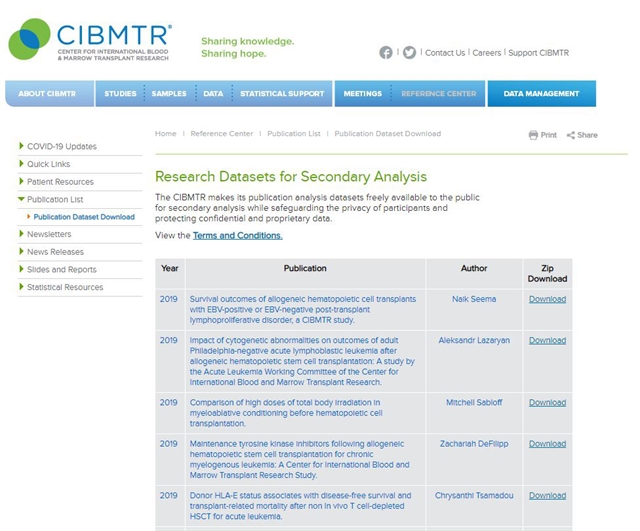
In accordance with the NIH Data Sharing Policy and NCI Cancer Moonshot Public Access and Data Sharing Policy, the CIBMTR makes the final datasets from published studies publicly available on the CIBMTR Research Datasets for Secondary Analysis webpage. These publication analysis datasets are freely available to the public for secondary analysis.
While providing these data, the CIBMTR is committed to safeguarding the privacy of participants and protecting confidential and proprietary data. Upon accessing the datasets page on the CIBMTR public website, the viewer is notified that the dataset was collected by the CIBMTR, and the CIBMTR's supporters are listed. The webpage also clearly notes the terms and conditions of dataset usage.
NEW datasets are now available online.
Our Supporters
The CIBMTR is supported primarily by Public Health Service U24CA076518 from the National Cancer Institute (NCI), the National Heart, Lung and Blood Institute (NHLBI), and the National Institute of Allergy and Infectious Diseases (NIAID); U24HL138660 from NHLBI and NCI; U24CA233032 from the NCI; OT3HL147741 and U01HL128568 from the NHLBI; HHSH250201700005C, HHSH250201700006C, and HHSH250201700007C from the Health Resources and Services Administration (HRSA); and N00014-20-1-2832 and N00014-21-1-2954 from the Office of Naval Research.
Additional federal support is provided by P01CA111412, R01CA100019, R01CA152108, R01CA218285, R01CA231141, R01CA231838, R01CA262899, R01AI128775, R01AI158861, R01HL130388, R01HL155741, R01HL131731, SC1MC31881, U01AI069197, U01AI126612, and UG1HL06924.
Support is also provided by Be The Match Foundation; Boston Children's Hospital; Dana Farber; St. Baldrick's Foundation; PBMTF; Stanford University; Medical College of Wisconsin; National Marrow Donor Program; and from the following commercial entities: AbbVie; Actinium Pharmaceuticals, Inc.; Adaptive Biotechnologies Corporation; Adienne SA; Allogene; Allovir, Inc.; Amgen, Inc.; Anthem; Astellas Pharma US; Atara Biotherapeutics; bluebird bio, inc.; Bristol Myers Squibb Co.; CareDx Inc; CRISPR; CSL Behring; CytoSen Therapeutics, Inc.; Daiichi Sankyo Co., Ltd.; Eurofins Viracor, DBA Eurofins Transplant Diagnostics; Fate Therapeutics; Gamida-Cell, Ltd.; Gilead; GlaxoSmithKline; HistoGenetics; Incyte Corporation; Iovance; Janssen Research & Development, LLC; Janssen/Johnson & Johnson; Jasper Therapeutics; Jazz Pharmaceuticals, Inc.; Kadmon; Karius; Kiadis Pharma; Kite, a Gilead Company; Kyowa Kirin; Legend Biotech; Magenta Therapeutics; Mallinckrodt Pharmaceuticals; Medac GmbH; Medexus; Merck & Co.; Millennium, the Takeda Oncology Co.; Miltenyi Biotec, Inc.; MorphoSys; Novartis Pharmaceuticals Corporation; Omeros Corporation; OptumHealth; Orca Biosystems, Inc.; Ossium Health, Inc; Pfizer, Inc.; Pharmacyclics, LLC; Priothera; Sanofi Genzyme; Stemcyte; Takeda Pharmaceuticals; Talaris Therapeutics; Terumo Blood and Cell Technologies; TG Therapeutics; Tscan; Vertex; Xenikos BV.
The views expressed in this newsletter do not reflect the official policy or position of the National Institute of Health, the Department of the Navy, the Department of Defense, Health Resources and Services Administration (HRSA), or any other agency of the US Government.
The CIBMTR® is a research collaboration between the National Marrow Donor Program (NMDP)/Be The Match and the Medical College of Wisconsin.
